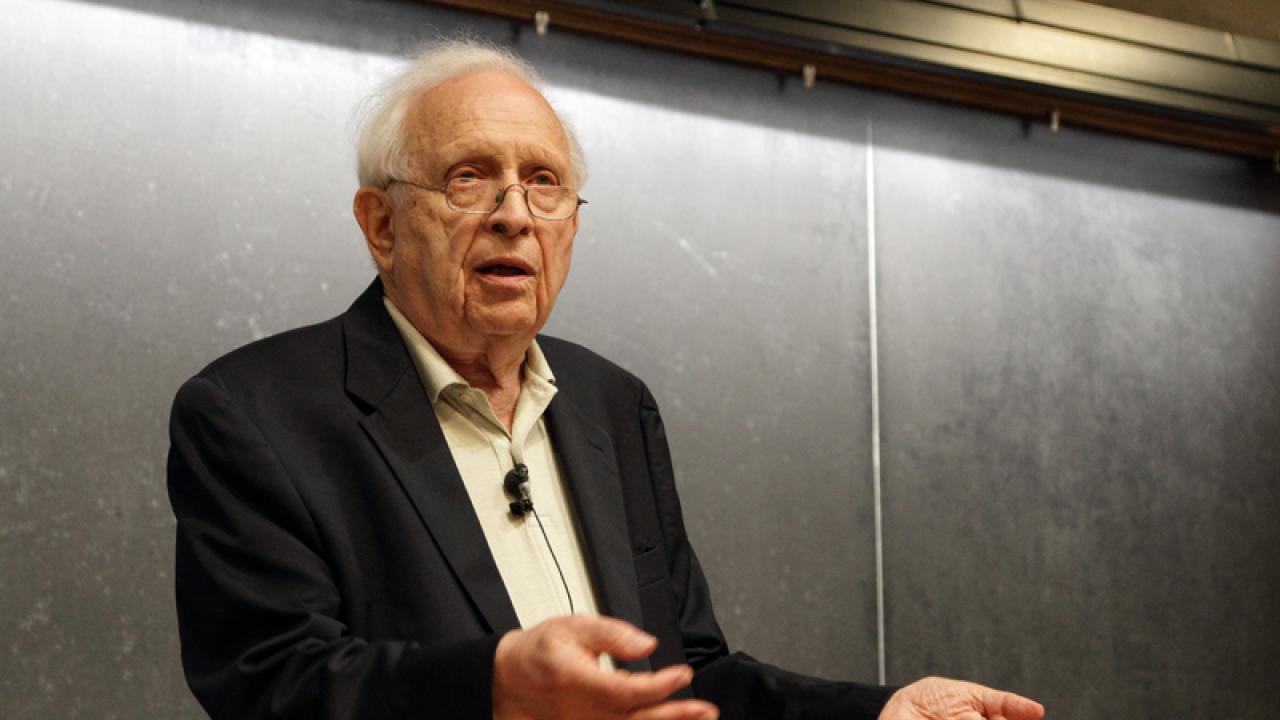
Any mystery-novel buff knows that when a stranger in a dark suit appears, the story's events are about to take an exciting turn. Such was the real case for Harvard Professor and 2005 Nobel Laureate Roy Glauber in October 1943.
Earlier that year, Glauber was an aspiring 17-year-old physicist studying at Harvard University and experiencing the repercussions following Japan's attack on Pearl Harbor. One-by-one, professors and students were leaving for war work, which forced the university to make significant changes to their academic curricula.
In September, Glauber turned 18 and began his part in the war by completing a questionnaire for the National Roster of Scientific Personnel. One month later, as he describes it, a "stranger in a dark suit" appeared at Harvard asking for him personally.
Following an interview in a shadowy room and instruction to retrieve a ticket in Chicago to an unspecified location in the western United States, Glauber found himself a part of a remote community in Los Alamos, New Mexico that was unlike any other. An intellectual bubble, the community, located in Los Alamos, New Mexico, consisted solely of scientists who all were working on a single, top-secret project - the likes of which had never been attempted and, if successful, could end the war, and did.
Last week, Glauber gave a public presentation at ICTP about the practical side of living in the community and the personal gains he made as an undergraduate physicist working on the Manhattan Project. For example Glauber recalls, with a chuckle, that when it rained in Los Alamos, he and his colleagues would trudge up to their ankles through the sinking mud. He remembers that when the mud dried it took on a brick-like quality that was difficult for them to remove from their shoes and pants.
As an undergraduate student at the time, Glauber says he worked in a group who studied a limited class of mathematical problems, which involved the development of how a nuclear chain reaction could generate an explosion. The problems included a number of difficult equations, which Glauber discovered some elegant tricks for solving, but only in certain cases.
In the end, he says the cases he considered did not solve the problem of the chain reaction as related to the project. Instead, his solutions were more of an advance in solving that flavor of mathematical equation, which in-and-of-itself Glauber considered a personal accomplishment.
"It was my first clear indication that this was research that nobody had ever done before and I seemed to be having some success with it," Glauber says. "I was only a student up to that point and it made me feel as though this was a field that I could enter. It was encouraging."
During the Manhattan Project, Glauber says he developed as much of an understanding of how physicists work as the mathematics he learned. Studying with and amongst some of the world's intellectual giants of physics and mathematics, like Robert Oppenheimer and Enrico Fermi, might be intimidating for some. Glauber, however, found reassurance from the experience.
"Learning how physicists worked was great," Glauber says. "To see the way they think about things, the way they gather ideas and why they throw out most of the bad ones had a certain real revelation to it. It made me think that I could do it when I had no assurance of that before."
When the project closed in 1945, Glauber returned to school. The experience left him with a distaste for secret work, which in an indirect way lead him to later choose a field of study unrelated to neutron diffusion and chain-reaction physics; a choice that paved the road to a Nobel Prize many decades later.
Glauber began to study optical coherence in the early 1960s. It's a field that deals with the property of light waves for limited, ideal cases that help conceptualize the physics of waves for scientists' understanding. Around the same time, lasers were emerging from theory to physical reality - by 1963, a handful of scientists had successfully created optical lasers.
Light from a laser acts differently than light from a light bulb, and Glauber was the first to explain why. In 1963, he published "The Quantum Theory of Optical Coherence", where he established a model to explain the fundamental behaviour of different types of light using quantum theory.
The paper laid the foundations for a quantum mechanical approach to optical coherence. Up to that point, scientists were using classical theory to study optical coherence, but the development of lasers threw a kink in the system which, Glauber discovered, only quantum theory could fix.
In October 2005 - an October that would prove very different, yet equally significant, from the one in 1943 - Glauber received an important phone call at 5:30 in the morning.
"I could only think of some other far-fetched things that could make for a phone call that early in the morning," Glauber recalls. "The real reason came as an absolute surprise."
The scientific community awarded the 2005 Nobel Prize in Physics to Glauber "for his contribution to the quantum theory of optical coherence", as well as John L. Hall and Theodor W. Hänsch "for their contributions to the development of laser-based precision spectroscopy, including the optical frequency comb technique".
Winning a Nobel Prize was a high-point for Glauber, and he says that he's been fortunate to have various other high-points over his career, many of which involved his collaboration with experimental physicists and developing explanations for some of their puzzling, observational results.
"When we found solutions we got this feeling that we'd really got it right and that there was a unique explanation. When that happens you can feel it immediately and there is something thrilling about it," Glauber says.
To help young, aspiring scientists discover what thrills them about science, Glauber has three words of advice: "Do what's interesting."













